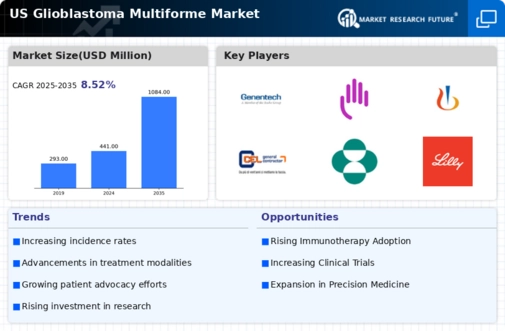Aging Population
The aging population in the United States is another significant driver impacting the glioblastoma multiforme market. As individuals age, the risk of developing various types of cancer, including glioblastoma, increases. Current demographic trends indicate that by 2030, approximately 20% of the U.S. population will be aged 65 and older. This demographic shift is likely to result in a higher incidence of glioblastoma, thereby increasing the demand for effective treatment options. Healthcare providers will need to adapt to the growing needs of this aging population, which may lead to an expansion of services and therapies available in the glioblastoma multiforme market. Consequently, the intersection of an aging population and rising cancer incidence presents a compelling opportunity for market growth.
Rising Incidence Rates
The glioblastoma multiforme market is experiencing growth due to the increasing incidence rates of this aggressive brain tumor. In the United States, the annual incidence of glioblastoma is approximately 3.19 cases per 100,000 individuals, which translates to around 13,000 new cases each year. This rising trend in diagnosis is likely to drive demand for innovative treatment options and therapies. As more patients are diagnosed, the healthcare system faces the challenge of providing effective care, thereby creating opportunities for pharmaceutical companies to develop and market new therapies. The increasing patient population is expected to contribute to the expansion of the glioblastoma multiforme market, as healthcare providers seek to address the unmet needs of these patients.
Growing Awareness and Advocacy
Growing awareness and advocacy for glioblastoma multiforme is emerging as a crucial driver in the market. Increased public and professional awareness about the disease is leading to more timely diagnoses and treatment interventions. Advocacy groups are actively working to educate the public and healthcare professionals about glioblastoma, which may result in heightened demand for specialized care and innovative therapies. Additionally, fundraising efforts and awareness campaigns are generating financial support for research initiatives, further propelling advancements in treatment options. As awareness continues to grow, the glioblastoma multiforme market is likely to benefit from increased patient engagement and a stronger push for effective solutions.
Investment in Research and Development
Investment in research and development (R&D) is a critical driver for the glioblastoma multiforme market. Pharmaceutical companies and research institutions are allocating substantial resources to discover novel treatment modalities. In recent years, R&D spending in oncology has surged, with estimates suggesting that it could reach $100 billion annually by 2025. This influx of funding is likely to accelerate the development of targeted therapies and immunotherapies, which may improve patient outcomes. Furthermore, collaborations between academia and industry are fostering innovation, leading to the emergence of new clinical trials and treatment options. As R&D efforts intensify, the glioblastoma multiforme market is poised for significant advancements, potentially transforming the landscape of treatment.
Regulatory Support for Innovative Therapies
Regulatory support for innovative therapies is playing a pivotal role in shaping the glioblastoma multiforme market. The U.S. Food and Drug Administration (FDA) has implemented various initiatives to expedite the approval process for breakthrough therapies, particularly in oncology. Programs such as the Breakthrough Therapy Designation and Accelerated Approval pathway are designed to facilitate faster access to promising treatments for patients with serious conditions. This regulatory environment encourages pharmaceutical companies to invest in the development of novel therapies for glioblastoma, potentially leading to a more diverse range of treatment options. As regulatory frameworks continue to evolve, the glioblastoma multiforme market may witness an influx of innovative therapies that could significantly improve patient outcomes.

















Leave a Comment